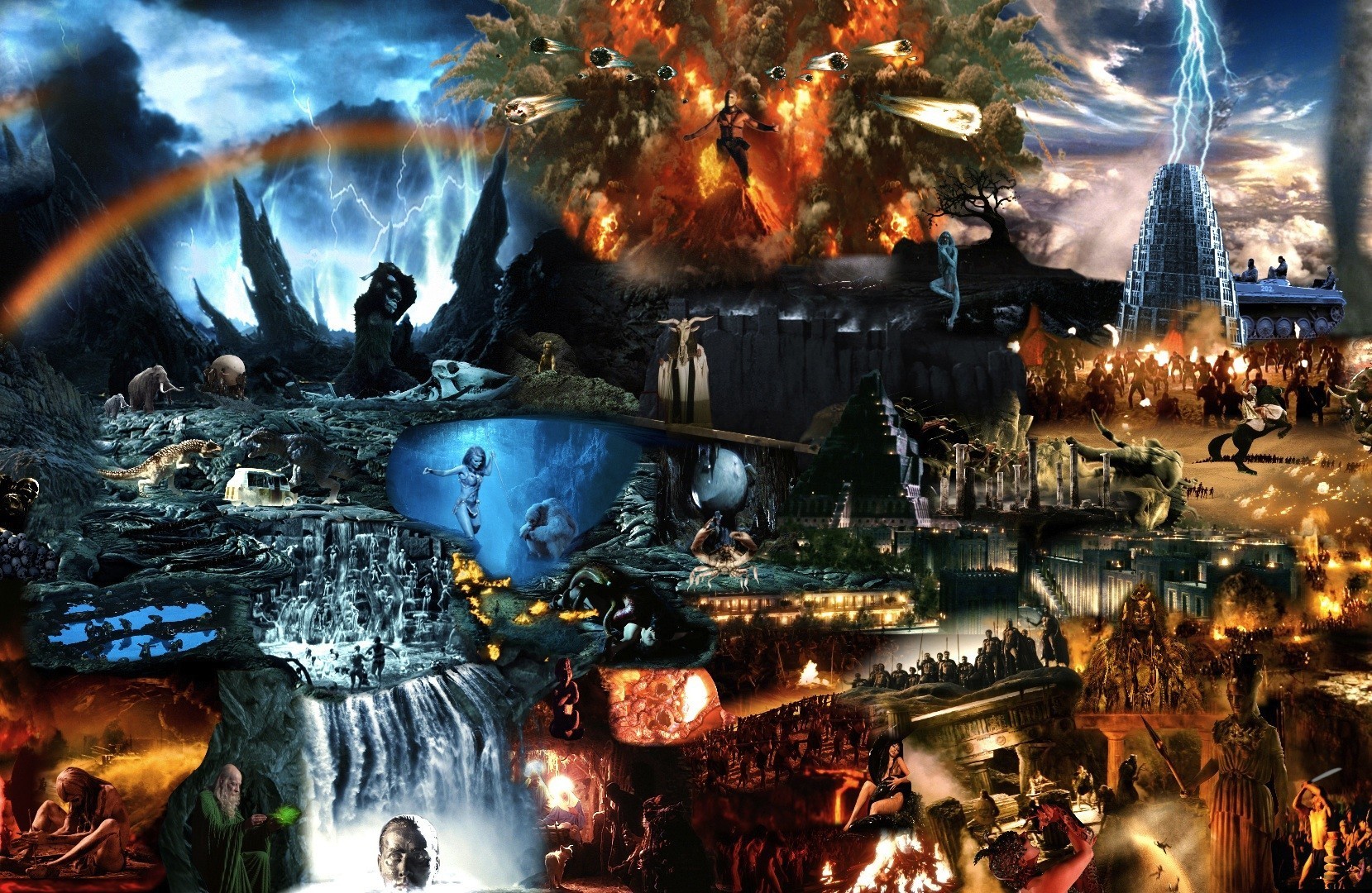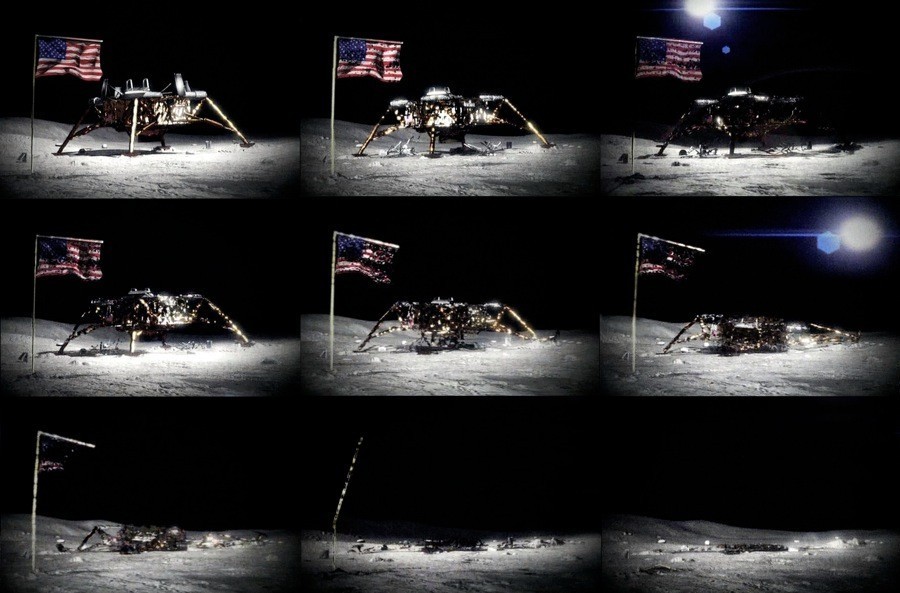After watching Marco Brambilla's 1992 film Demolition Man, audiences would have felt a sense of finality. The credits rolled, the lights went up and the viewers left the theater. The film was over.
In Brambilla's latest video works, on display in "The Dark Lining" at the Santa Monica Museum
of Art through August 20, the endings aren't so conclusive. Each of the videos is looped and the "end" only leads seamlessly back into the beginning.

Evolution (Megaplex), 2010
Nowhere is this more apparent than the colossal "Civilization" and "Evolution," both stunning three-dimensional assemblages of characters displaying the full spectrum of human emotion. "Civilization" progresses through the seven deadly sins to an ecstatic, bluish heaven, which dominates the screen for a few seconds before giving way once again to evil. At the end of these videos, you might give your friends an incredulous glance, but you don't get up and leave.

Sea of Tranquility, 2006
The works command repeated viewings for a variety of reasons. The above-mentioned pieces are too dense with imagery to absorb in a single viewing, even if the forehead-smacking originality weren't enough to keep you in your seat. "Sea of Tranquility" shows a moon-lander module decaying and collapsing in time-lapse, and its sudden reconstruction as the video repeats is devastating, like seeing baby pictures at a loved-one's funeral.
The drama of these "films"--if you can call them that--is contained not in plot but in the attention-commanding trance we slip into when watching. They represent a new format entirely, and audiences are fortunate that Brambilla has introduced it with such triumphant work.
The Huffington Post interviewed Brambilla, and the full interview is included below the following slideshow. Take a look at the images and don't forget to restart the videos after they appear to end.
Your videos in "The Dark Lining" are populated with loops and cycles, particularly "Civilization" and "Evolution." What appeals to you about looped video?
In the sampled work, I use loops to remove the narrative from the original context, to make it more abstract in a way. There’s also a hypnotic quality to looping movement, similar to listening to the same sound over and over.
In Civilization and Evolution, the loops create a synchronized sense of movement and give the collage an overall choreography. You get the feeling the characters are somehow trapped in time - forever repeating gestures and movements. A ritual, a procession and a sense of inevitability comes out of this as they move up into the heavens, or in the case of Evolution, into the future and their destiny.
For Wall of Death I used video loops to simulate the cyclical effect of watching a kinetoscope. This was a motion picture viewing device from the same era of the carnival attraction that served as the subject for the piece. The motion loops create a rhythm that gradually builds to 6 or even 2 frame cuts by the end of the piece.
On a similar note, in "Evolution," the setting builds to a sort of technological singularity, only to be cut off and returned back to prehistory. To what extent can you construct a narrative even as a video repeats?
Most of my work has no conventional narrative so it’s not essential to have a beginning and an end - your attention can flow in and out of the experience rather than having a set entry point. In Evolution one of the themes is the cycle of life (and death) - we are seen in constant state of conflict. In the canvas the sense of conflict connects the past and the future.
Is it the same with "Civilization?" Does Hell come after Heaven?
Yes, the cycle is closely linked to the subject - it blurs the boundaries between heaven and hell. Indulgence is represented everywhere and the images are seen as over-sensationalized regardless of their location. It’s all about spectacle and sensory overload.
Kanye West said your piece for [his single] "Power" is "not a video...it's a painting," and that statement could be applied to your newest work as well. Do you agree with that? What can make a video a painting? Do you see the film clips as your brush strokes?
Bosch and Bruegel paintings were an inspiration for the video canvases – setting the composition in motion adds a visual narrative that’ s connected to media and film. In the Power video, the frescoes in the Sistine chapel were a major reference.
I do use the loops as brushstrokes in a way, whether they are sampled or shot specifically for the work. In the video collage pieces, the samples are reprocessed into a composition over-saturated with imagery. The 3D component was a natural progression, making the spectacle more dense, more epic, more bombastic - our ability to absorb images is pretty astonishing.
Many of the films you excerpt in the two 3D pieces were blockbusters in their time. Have their characters become our default images of technological and moral evolution? Were there certain moral attitudes that you found to be underrepresented in popular film history?
The iconic characters in Evolution serve as signposts in time; they represent the collective consciousness of their era, a kind of pop version of subliminal film memory. I looked through a lot of foreign cinema for some of the more provocative imagery and everything, virtually every genre you can think of is pretty well represented.
Lastly, I'm just curious: how did you become interested in Counterstrike? Have you played it?
I was watching an editor at my studio playing counterstrike and became fascinated with the intensity of it. When you’re in Counterstrike, your sole objective is survival, and you are forced to focus - there’s an elegant simplicity to the experience. I’ve played a few times but never lasted more than a few minutes.
